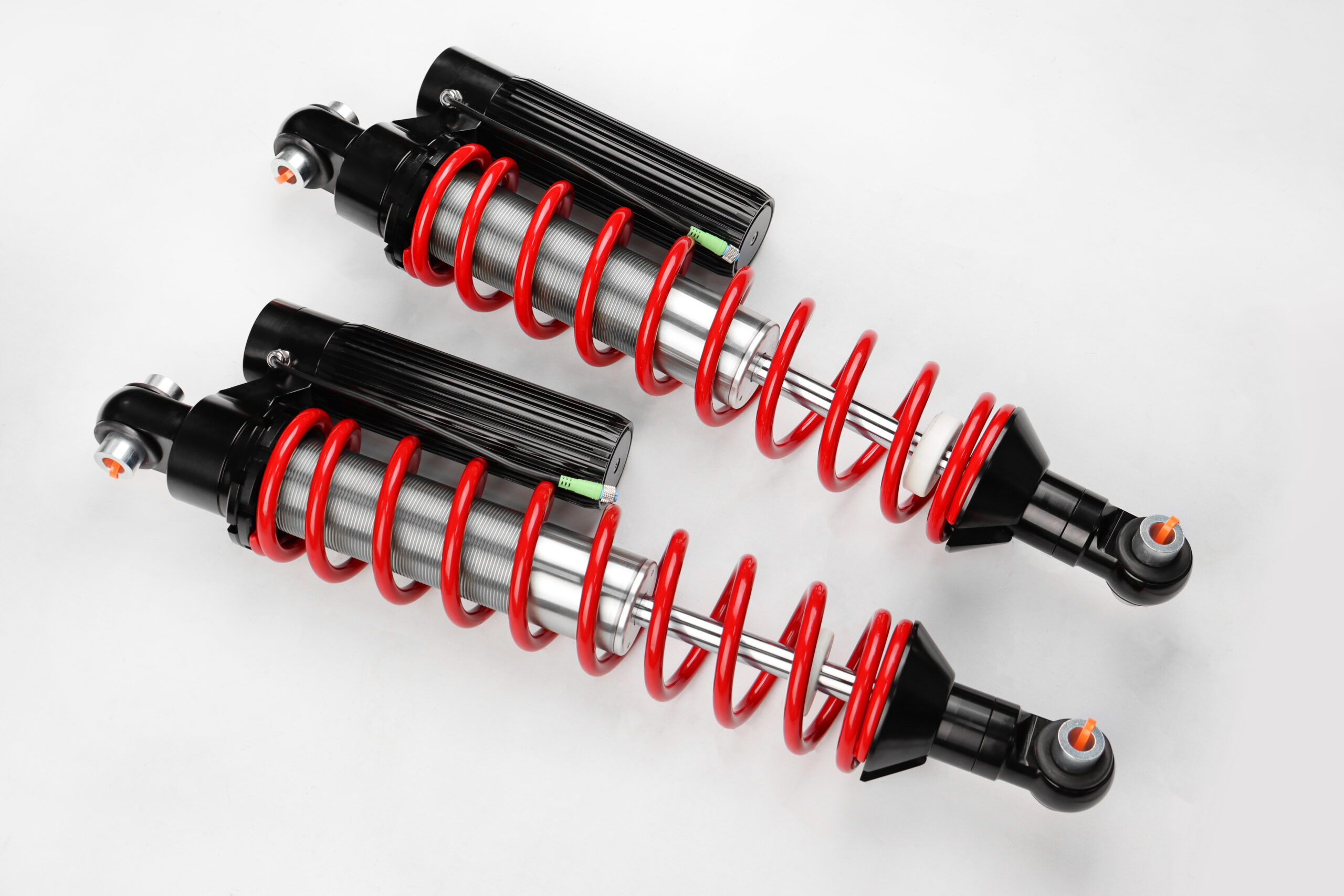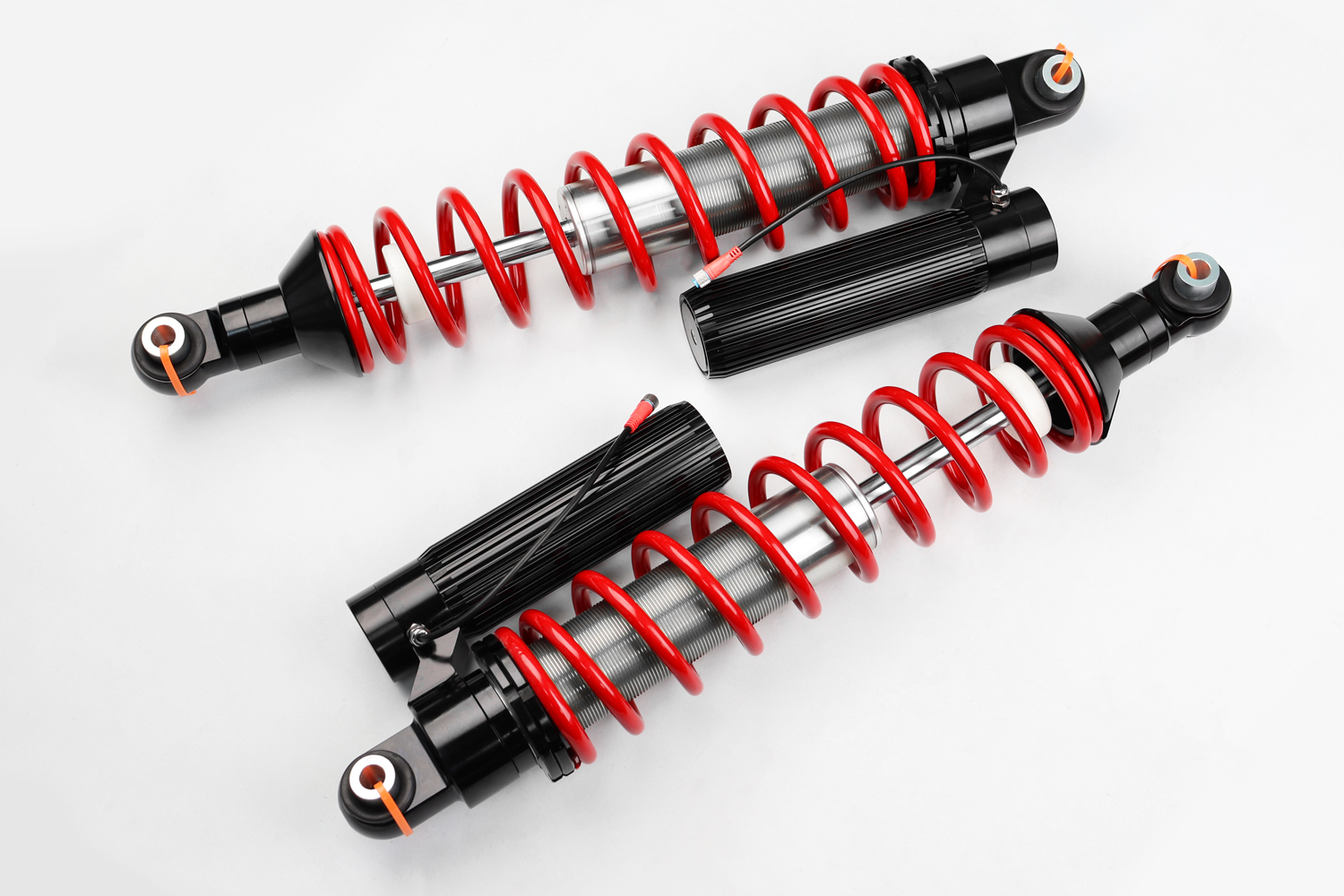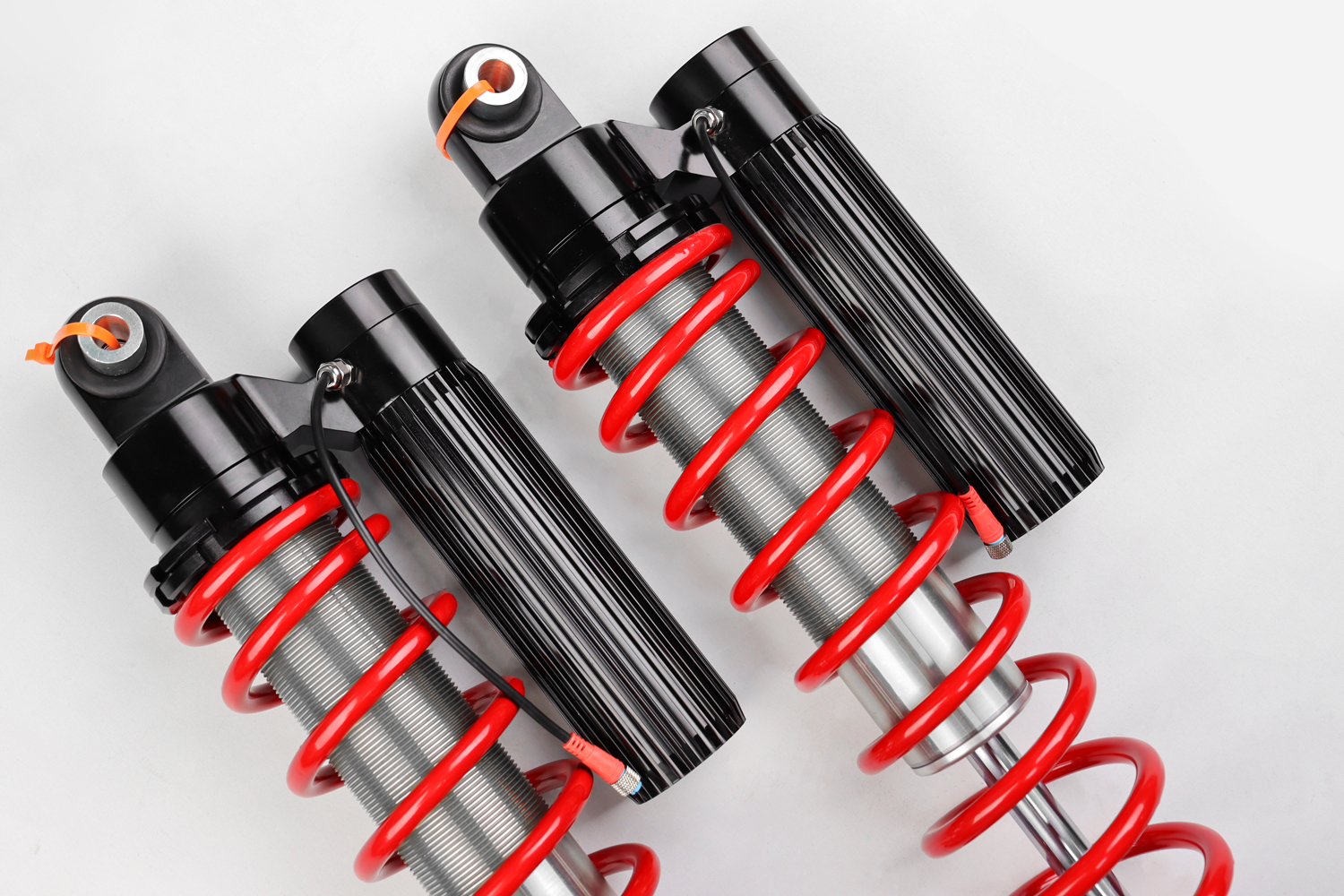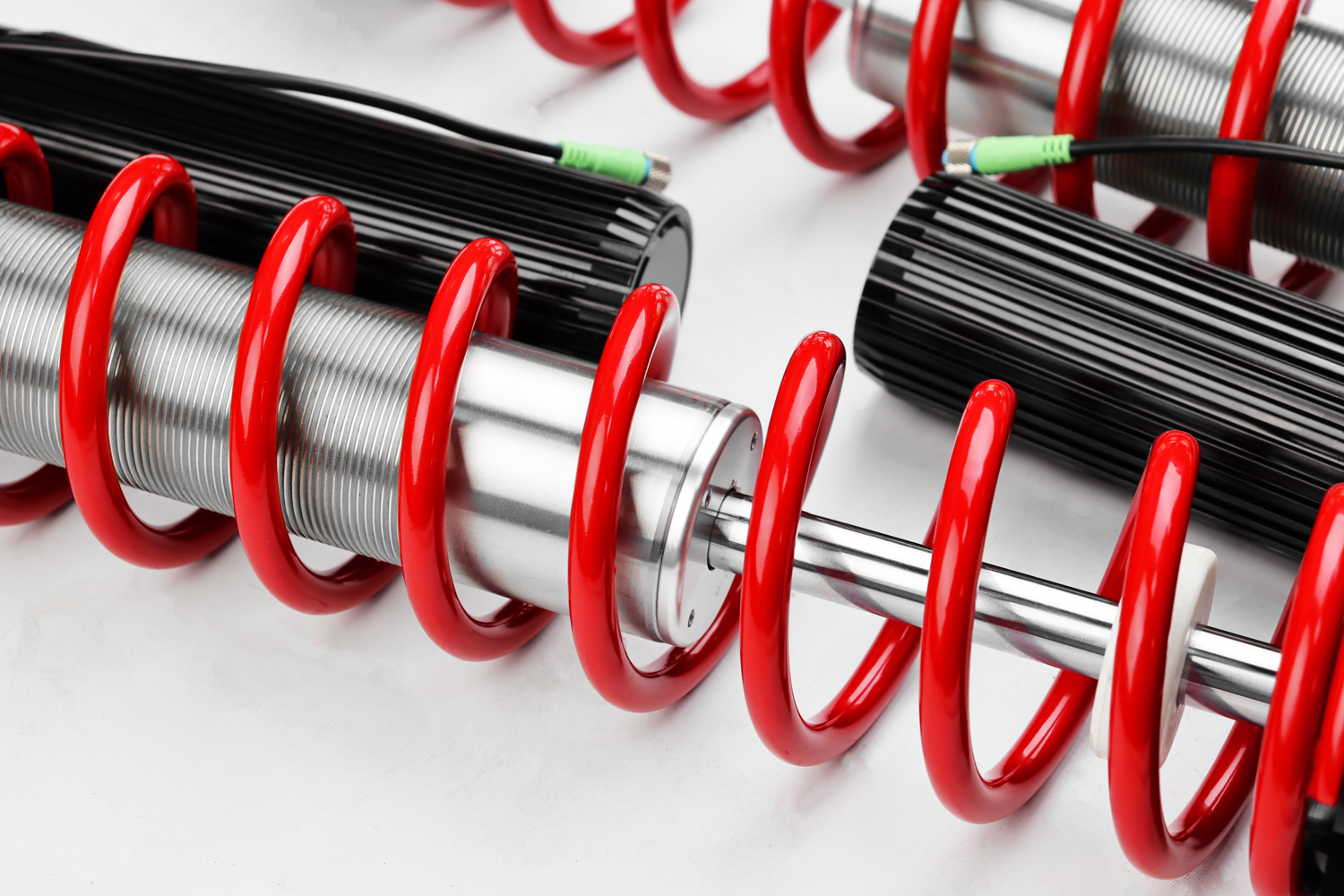What is a High-Pressure Suspension System? An In-Depth Guide for Automotive Professionals
أغسطس 25, 2025
شارك هذه المقالة
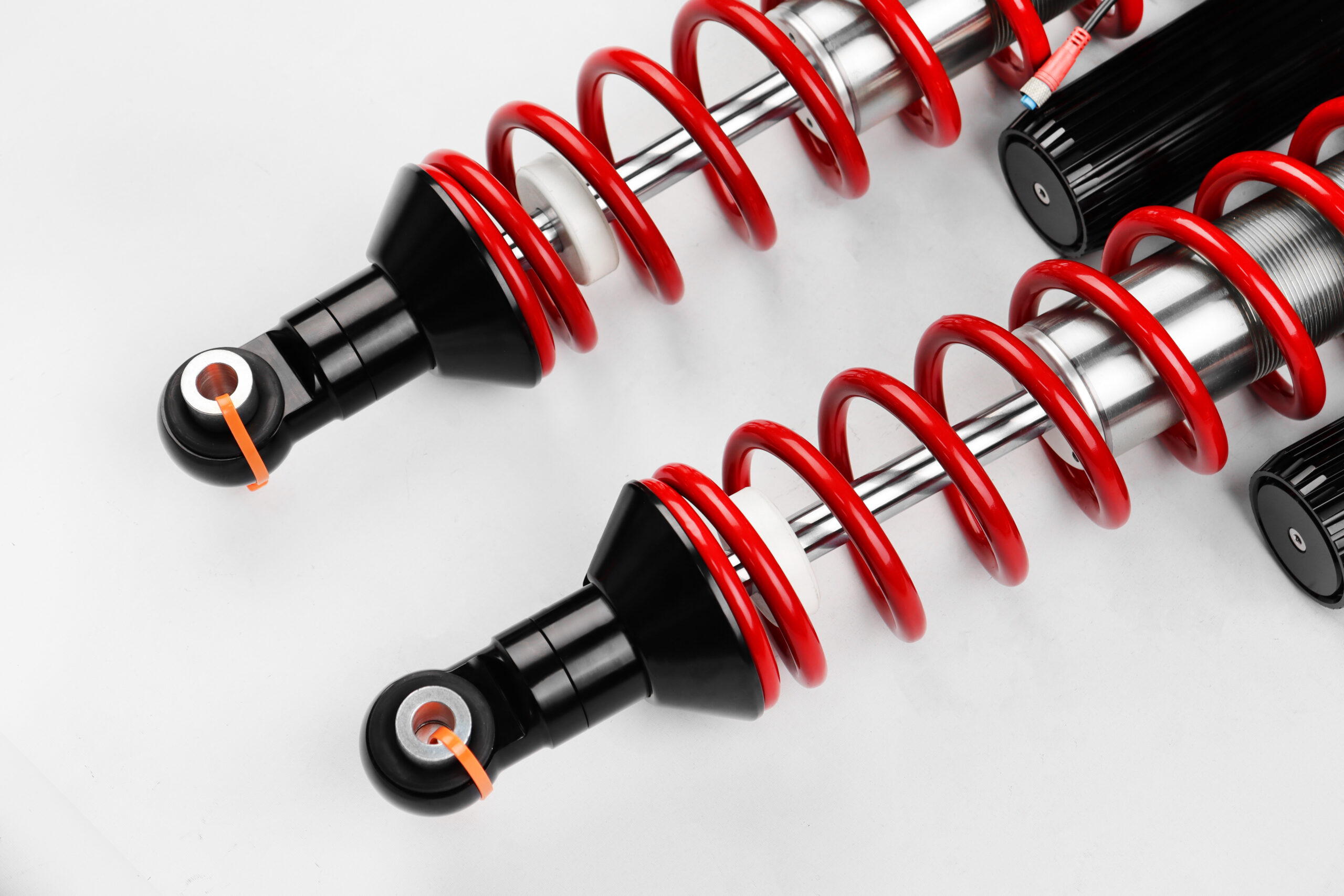
What is a High-Pressure Suspension System?
أ high-pressure suspension system is a specialized type of automotive suspension that uses pressurized gas (typically nitrogen), الهيدروليكية fluid, or a combination of both to improve vehicle stability, handling, and shock absorption under extreme conditions. Commonly used in off-road racing, military vehicles, and high-performance modified cars, these systems are engineered to perform where conventional suspensions fail.
Core Components of a High-Pressure Suspension System:
| المكون | الوصف |
|---|---|
| Gas Reservoir | Stores nitrogen or other inert gases under high pressure |
| Hydraulic Piston/Valve | Controls fluid flow and regulates damping response |
| ممتص الصدمات | Converts kinetic energy into thermal energy to reduce oscillation |
| Accumulator | Separates gas and fluid to maintain consistent performance |
| Control Valves | Adjusts compression and rebound characteristics dynamically |
Key Technical Features:
- Pressure levels: Typically range from 200 to 400 psi depending on application
- قابلية تعديل التخميد: Multi-stage adjustability for compression and rebound
- Temperature resistance: Designed to operate between -40°C to 150°C
- Material composition: Aerospace-grade aluminum, chrome-moly steel, or titanium
Benefits for B2B Clients:
- Enhanced product offerings for OEM and aftermarket catalogs
- Competitive edge for racing teams and performance garages
- Customizability for niche applications like armored or expedition vehicles
If you’re a wholesaler or brand owner looking to upgrade your inventory with high-performance shock absorber systems, G·SAI offers OEM-grade custom high-pressure suspension systems tailored for off-road and racing markets. Learn more about our shock absorber product line.
Applications of High-Pressure Suspension Systems in Off-Road and Racing Vehicles
High-pressure suspension systems are built to withstand the harshest environments, making them essential in numerous high-demand automotive sectors. Below are the most common B2B applications where these systems demonstrate superior performance:
1. Off-Road Performance Vehicles
- Rally raid trucks
- Desert buggies
- All-terrain vehicles (ATVs)
- زواحف الصخور
These vehicles often require long-travel suspension and high resistance to repeated impacts, which high-pressure systems provide.
2. Racing Cars and Motorsports
- Baja and Dakar Rally vehicles
- Circuit racing cars (e.g., GT3, Time Attack)
- Drift and drag racing vehicles
High-pressure systems offer real-time damping adjustments and heat-resistance, essential for performance consistency during races.
3. المركبات العسكرية والتكتيكية
- Armored personnel carriers (APCs)
- Reconnaissance vehicles
- Rapid deployment units
The durability and adaptability of high-pressure suspensions reduce wear and tear in mission-critical operations.
4. Heavy-Duty Utility Vehicles
- Mining trucks
- Forest service equipment
- Construction vehicles
In these sectors, downtime equals lost revenue. High-pressure systems extend maintenance intervals and enhance operational reliability.
Types of High-Pressure Suspension Systems for Automotive OEM and Aftermarket
Understanding the different types of high-pressure suspension systems is essential for B2B buyers, especially when sourcing components for different vehicle platforms or performance goals.
1. Monotube High-Pressure Shocks
| الميزة | الوصف |
|---|---|
| التصميم | Single-cylinder design with floating piston |
| الأداء | Better cooling, quicker response |
| حالة الاستخدام | Ideal for racing and performance vehicles |
| التكلفة | متوسط إلى مرتفع |
2. Remote Reservoir High-Pressure Shocks
| الميزة | الوصف |
|---|---|
| التصميم | Separate reservoir connected by hose |
| الأداء | Increased oil and nitrogen capacity, less cavitation |
| حالة الاستخدام | Off-road, long-travel suspensions |
| التكلفة | مرتفع |
3. Adjustable High-Pressure Systems
| الميزة | الوصف |
|---|---|
| Compression/Rebound | Manually or electronically adjustable damping |
| حالة الاستخدام | Tuned driving experiences, variable terrain |
| التكلفة | متوسط إلى مرتفع |
4. Air-Over-Hydraulic Systems
| الميزة | الوصف |
|---|---|
| التصميم | Incorporates air spring and hydraulic damping |
| حالة الاستخدام | Luxury SUVs, expedition vehicles |
| التكلفة | مرتفع |
Industry Use Case Matching Table
| قطاع الصناعة | نوع النظام الموصى به | الفائدة الرئيسية |
|---|---|---|
| Off-road Racing Teams | Remote Reservoir High-Pressure Shocks | Extreme durability and cooling |
| Modified Car Dealers | Adjustable High-Pressure Systems | Custom tuning and ride control |
| OEM Vehicle Assemblers | Monotube High-Pressure Shocks | Cost-effective with solid performance |
| Heavy Equipment OEM | Air-Over-Hydraulic Systems | Comfort and performance balance |
Looking for a supplier that offers all these systems under one roof? Check out G·SAI’s manufacturing capabilities, including CNC machining, simulation labs, and custom engineering for your B2B needs.
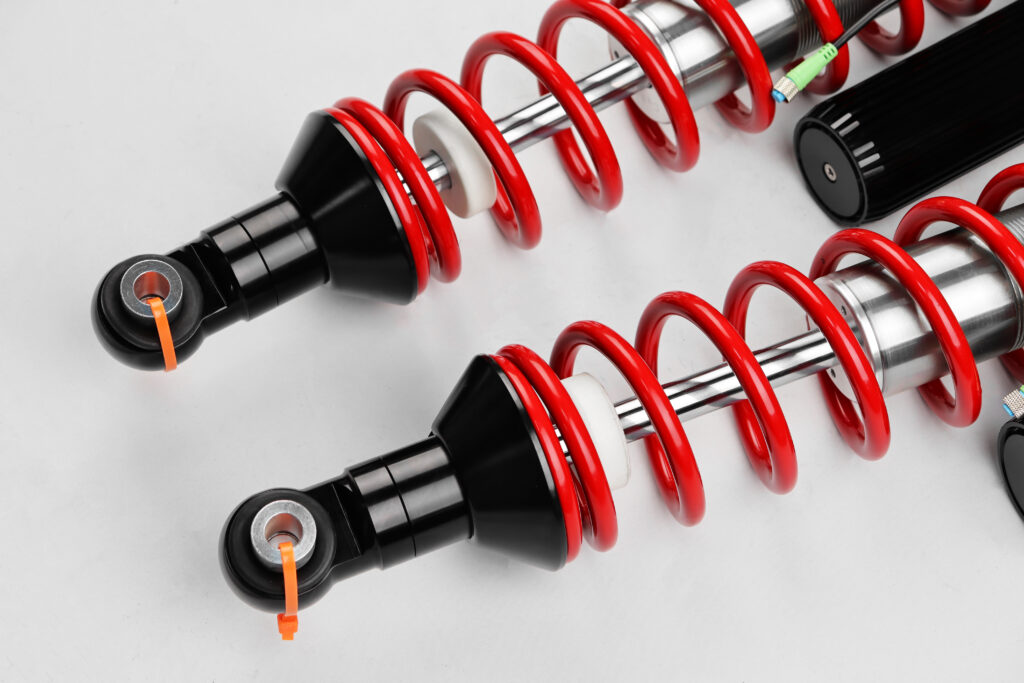
Solutions with High-Pressure Suspension Systems for Vehicle Performance Optimization
For automotive brands, off-road racing teams, and performance aftermarket suppliers, integrating high-pressure suspension systems can significantly enhance vehicle performance, customer satisfaction, and brand differentiation. Let’s break down how these systems deliver real-world solutions across various B2B scenarios.
1. Performance Benefits for End Users
Whether you’re supplying parts to racing teams or outfitting high-performance SUVs, high-pressure suspension systems offer measurable performance improvements:
| مقياس الأداء | High-Pressure Suspension Impact |
|---|---|
| راحة الركوب | Maintains consistent damping over rough terrain |
| Handling & Stability | Reduces body roll and improves cornering precision |
| تبديد الحرارة | Prevents fade in high-temperature racing or desert conditions |
| التعامل مع الأحمال | Supports heavy loads without compromising ride quality |
| Shock Longevity | Reduces internal wear and extends service intervals |
These benefits lead to fewer product returns, enhanced brand loyalty, and better ROI for your customers.
2. Business Solutions for Wholesalers & Distributors
Distributors and wholesalers seeking to expand their product line can benefit from offering high-pressure suspension systems in several ways:
- High-margin aftermarket sales: These systems cater to a premium customer segment.
- Diverse customer base: Ideal for off-road, motorsports, armored vehicle, and utility vehicle markets.
- Repeat business potential: Customers return for tuning, upgrades, or multi-vehicle outfitting.
3. Custom Engineering for Specialized Applications
High-pressure suspension systems can be engineered to meet custom vehicle requirements. This is particularly useful for:
- شراكات OEM
- SXS and UTV manufacturers
- RV builders
- Tactical vehicle producers
G·SAI, for example, provides one-on-one customization services using simulation labs and real-time testing facilities. With a dedicated engineering team led by 17-year suspension veteran Cai Xianyun, G·SAI delivers ممتصات صدمات مخصصة built for specific vehicle weights, terrains, and performance goals.
👉 Connect with our engineering team to discuss your custom suspension solution.
High-Pressure Suspension Systems vs. Traditional Suspension: B2B Buyer Comparison Guide
Choosing between a high-pressure suspension system and a traditional suspension setup can be difficult, especially when making bulk procurement decisions. Here’s a side-by-side comparison for B2B buyers:
Feature Comparison Table
| الميزة | High-Pressure Suspension | نظام التعليق التقليدي |
|---|---|---|
| اتساق التخميد | Excellent under extreme loads | Degrades with heat and use |
| القدرة على التكيف مع التضاريس | Superior, especially off-road | Limited to moderate terrain |
| فاصل الصيانة | Longer, fewer service issues | Shorter, frequent component wear |
| سعة التحميل | High, adjustable | Fixed, with limited customization |
| التكلفة | Mid to High | Low to Mid |
| "G-SAI تصنع ممتصات صدمات النيتروجين القابلة للتعديل للتحكم الإلكتروني TOYOTA BJ40 | بديل OEM لشاحنة/سيارة دفع رباعي TOYOTA | Available for OEM and private label | Limited custom options |
| Appeal to Performance Market | قوي | Weak |
Ideal Use-Case Scenarios
- Choose High-Pressure Suspension if your market involves:
- High-speed off-road racing
- Military or expeditionary vehicles
- Tuned or modified performance vehicles
- High-value aftermarket resellers
- Choose Traditional Suspension if your market involves:
- Budget-conscious consumers
- Low-risk urban driving
- Fleet vehicles with minimal performance requirements
Why B2B Buyers Prefer High-Pressure Systems
- أعلى customer satisfaction and repeat orders
- Improved تحديد مكانة العلامة التجارية in a niche, premium market
- Possibility for تكامل المعدات الأصلية or private label branding
Distributors looking to enter or expand in the high-end suspension market should consider a supplier like G·SAI, who offers OEM-level customization, technical support, and fast lead times. Explore our dealer network and partnership opportunities.
How to Assemble or Retrofit a High-Pressure Suspension System
For B2B customers dealing with retrofit kits, vehicle assembly, or aftermarket upgrades, understanding the assembly process of a high-pressure suspension system is essential to reduce labor costs and installation errors.
الأدوات المطلوبة
- رافعات هيدروليكية أو حوامل رافعة
- مفتاح عزم الدوران
- Nitrogen charging kit
- Shock spanner wrenches
- Thread locker and anti-seize
- Manufacturer-specific mounting hardware
دليل التثبيت خطوة بخطوة
- Vehicle Preparation
- Secure the vehicle on a lift or jack stands.
- Remove the wheels and existing suspension components.
- Mounting the New Shocks
- Install brackets (if necessary) for remote reservoir shocks.
- Align and bolt in the shock absorber using supplied hardware.
- Torque to manufacturer specs.
- Connecting Remote Reservoir (if applicable)
- Mount the reservoir to chassis or control arms.
- Ensure hose routing avoids heat sources or moving parts.
- شحن النيتروجين
- Use a charging kit to pressurize the shock to the recommended psi.
- Typical pressure: 200–400 psi depending on model.
- تعديل التخميد
- Set rebound and compression based on the vehicle’s weight and usage.
- Recommended: Start with midpoint settings and fine-tune during test drives.
- الفحوصات النهائية
- أعد تركيب العجلات وأنزل السيارة.
- Perform a test drive and check for leaks or abnormal noises.
- Re-torque bolts after 100–200 km.
Tips for B2B Installers or Dealerships
- تقديم installation as a value-added service to increase margins.
- Include setup guides or video tutorials for your reseller network.
- Bundle with alignment services or ride height calibration.
G·SAI supplies comprehensive installation manuals and technical training for its distributors and partners, making it easier to scale your operations. Learn more about our technical capabilities.
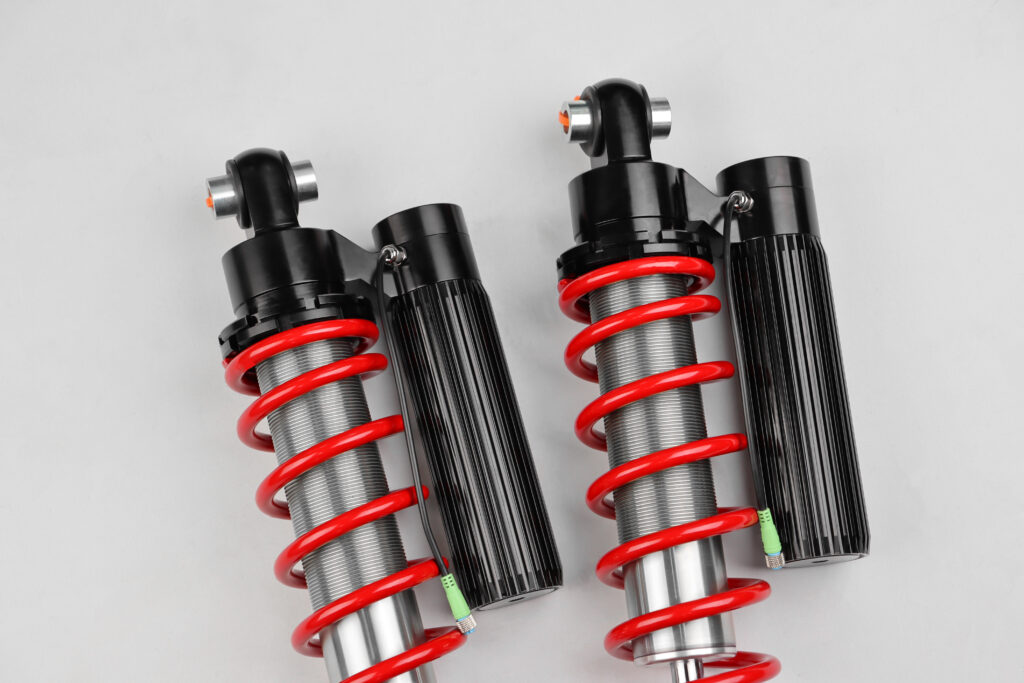
How to Choose the Right High-Pressure Suspension System for Your Automotive Business
اختيار المناسب high-pressure suspension system is a critical decision for B2B buyers, whether you’re a wholesaler, distributor, OEM, or performance garage. The right choice affects not only customer satisfaction but also your brand reputation, cost efficiency, and long-term business scalability.
Here’s a comprehensive guide to help automotive professionals make the optimal selection based on vehicle type, terrain, market demand, and other business-critical factors.
1. Define Your Target Application and Customer Base
Before selecting a suspension system, segment your customer profiles:
| شريحة التطبيق | نوع العميل | المتطلبات الأساسية |
|---|---|---|
| Off-road racing & rally teams | Performance-focused end users | Extreme durability, heat resistance, tunability |
| Modified 4×4 and SUVs | Enthusiasts and custom shops | Adjustable ride height, aggressive damping |
| Heavy-duty utility vehicles | OEMs and fleet managers | Load support, low maintenance, reliability |
| RVs & overlanding vehicles | Adventure travelers, RV suppliers | Comfort, stability, long-distance endurance |
Once you define your customer base, you can match the suspension system that best solves their problems.
2. Understand Key Technical Specs
High-pressure suspension systems vary in performance specs. Here are the most important specs to compare when sourcing:
| Specification | الوصف |
|---|---|
| قابلية تعديل التخميد | Number of settings for compression and rebound (e.g., 3-way, 5-way, infinite) |
| مادة هيكل الصدمة | Aluminum, chrome-moly steel, or titanium for weight and durability |
| نوع الخزان | Internal, piggyback, or remote reservoir affects cooling and installation flexibility |
| نطاق الحركة | Important for off-road and lifted vehicle applications |
| درجة حرارة التشغيل | Affects performance in desert, snow, or racing conditions |
| Pressure Rating | PSI range supported; relevant for nitrogen charging and tuning |
3. Prioritize Customization Capabilities
If your business involves private labeling or OEM supply, customization is non-negotiable. Look for suppliers who offer:
- Custom valving and damping curves
- Branding options (logos, packaging)
- ضبط خاص بالمركبة
- CAD modeling and prototyping
- Low-volume production capabilities
G·SAI is equipped with a full-scale ورشة عمل التصنيع باستخدام الحاسب الآلي, معمل المحاكاةو غرفة تعديل المركبات, enabling rapid prototyping and low-to-medium batch production. This makes it an ideal partner for private-label suspension systems or OEM collaborations. Explore G·SAI’s custom manufacturing capabilities.
4. Evaluate Supplier Support & After-Sales Service
B2B buyers need more than just product specs—they need dependable support. Evaluate your supplier based on:
- يمكن أن تتراوح المهلات الزمنية
- Technical consultation availability
- Product documentation
- Return and warranty policies
- On-site or remote training
G·SAI provides a dedicated technical team and customization consultant for each partner, ensuring smooth integration into your product line or project.
Custom High-Pressure Suspension System Solutions: Everything You Need to Know
Custom high-pressure suspension systems are increasingly popular among OEMs, racing teams, and specialty vehicle builders. These solutions offer tailored performance characteristics, brand differentiation, and specific tuning advantages. Here’s what businesses need to know before investing in custom suspension development.
1. When to Consider Custom Suspension Systems
| السيناريو | Why Custom is Better |
|---|---|
| Launching a new vehicle model | Tailored suspension matches design and performance |
| Entering a niche market (e.g., overlanding, armored vehicles) | Off-the-shelf shocks may not meet performance demands |
| Offering private-label performance parts | Builds brand identity and control over specs |
| Participating in competitive motorsports | Gains edge through tuning and weight optimization |
2. Custom Development Process
Working with an experienced manufacturer simplifies the customization process. G·SAI follows a structured development pipeline:
- تحليل المتطلبات
Define vehicle type, load, terrain, and performance goals. - الهندسة والمحاكاة
CAD modeling, finite element analysis (FEA), and dynamic simulations. - Prototype Manufacturing
Small-batch CNC machining and shock assembly for validation. - اختبار المركبات
Real-world testing on G·SAI’s in-house track or customer-provided vehicles. - Feedback & Tuning
Adjust valving, nitrogen pressure, and rebound/compression rates. - Final Production
Scaled production with quality assurance and full documentation.
3. What to Look for in a Custom Suspension Partner
| معايير التقييم | لماذا يهم |
|---|---|
| فريق الهندسة الداخلي | Faster development cycles and expert support |
| Testing capabilities | Ensures performance under real-world conditions |
| Material sourcing and traceability | Guarantees quality and regulatory compliance |
| Flexible production volume | Supports prototypes, small runs, and full-scale production |
| خدمة ما بعد البيع | Critical for warranty, tuning advice, and installation help |
G·SAI’s custom shock absorber service is trusted by racing teams, tactical vehicle builders, and RV manufacturers worldwide. With a 17-year veteran as the lead engineer and a fully equipped facility, G·SAI delivers precision, performance, and reliability. Contact us to start your custom project.

FAQ: High-Pressure Suspension Systems for Wholesalers, Racing Teams & Distributors
Below are frequently asked questions from B2B clients considering high-pressure suspension systems for their inventory or vehicle platforms.
Q1: What’s the difference between high-pressure and low-pressure suspension systems?
إجابة: High-pressure systems use nitrogen gas at pressures typically above 200 psi, offering more consistent damping, better heat resistance, and superior performance under extreme conditions. Low-pressure systems, while cheaper, are prone to cavitation and performance fade.
Q2: Can I order custom-branded high-pressure shocks for my brand?
إجابة: Yes. G·SAI offers private label services including custom valving, packaging, and branding. It’s ideal for performance parts dealers and 4×4 accessory brands looking to expand their product range.
Q3: Are high-pressure suspension systems compatible with all vehicle types?
إجابة: Not always. These systems are best suited for performance vehicles, off-road platforms, and heavy-duty applications. G·SAI offers engineering consultation to determine compatibility and tuning requirements.
Q4: What kind of support does G·SAI offer post-purchase?
إجابة: G·SAI provides technical consultations, installation guides, tuning support, and a dedicated after-sales service team. Whether you’re a small shop or a global distributor, support is tailored to your business scale.
Q5: How do I become a distributor or sales partner?
إجابة: قم بزيارة صفحة شبكة وكلاء G-SAI to apply. We offer tiered pricing, marketing support, and logistics assistance for global partners.
If you’re ready to elevate your brand with custom-engineered, high-performance suspension systems, G·SAI is your trusted partner in China. With proven results in racing environments and extreme off-road applications, we deliver shock absorbers engineered for excellence.
👉 Explore G·SAI’s full product offerings أو contact us to discuss your wholesale needs. Let’s redefine suspension performance—together.

